A) it is a depositional contact,probably representing only a short period of geologic time
B) it is an angular unconformity in most places and a nonconformity where it overlies granite
C) it generally is an unconformity and represents more time in the right part of the diagram than in the left part of the diagram
D) all of these
Correct Answer

verified
Correct Answer
verified
Multiple Choice
Using the data in this table,determine the age of the dike. 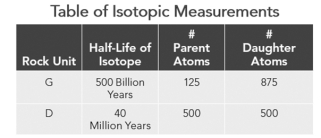
A) 500
B) 1,000
C) 40,000,000
D) 500,000,000
E) 1,000,000,000
Correct Answer

verified
Correct Answer
verified
Multiple Choice
Which numbered layer in this photograph represents the youngest layer? 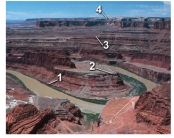
A) 1
B) 2
C) 3
D) 4
Correct Answer

verified
Correct Answer
verified
Multiple Choice
What is the youngest event represented in this block diagram? 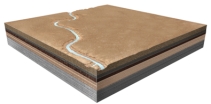
A) formation of the lowest layer
B) deposition of the top layer
C) erosion of a canyon by a river
D) retreat of the seas
Correct Answer

verified
Correct Answer
verified
Multiple Choice
What strategies do we use to investigate human origins?
A) the same relative-dating principles we apply to older rocks
B) finding pieces of an older wall in younger deposits
C) determining carbon-14 ages on bones,wood,and charcoal
D) dating interbedded volcanic rocks
E) all of these
Correct Answer

verified
Correct Answer
verified
Multiple Choice
This figure shows the geologic timescale.Which period listed below would be part of the Mesozoic? 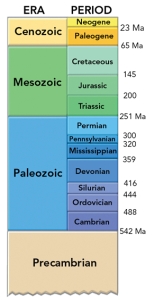
A) Neogene
B) Jurassic
C) Pennsylvanian
D) Mississippian
E) Cambrian
Correct Answer

verified
Correct Answer
verified
Multiple Choice
If you were trying to correlate these two sequences of rocks,what would probably be the most straightforward strategy to use? 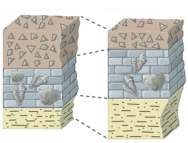
A) determine numeric ages on pieces of rock in the landslide on top
B) compare the fossils of the middle layers
C) compare the thicknesses of the middle layer
D) compare the thicknesses of the lower layer
Correct Answer

verified
Correct Answer
verified
Multiple Choice
Which of following geologic events is the youngest? 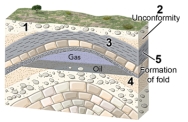
A) deposition of the shale (3)
B) deposition of the lower units (4)
C) formation of the fold (5)
D) accumulation of the oil and gas
Correct Answer

verified
Correct Answer
verified
Multiple Choice
What kind of geologic feature is shown in this photograph? 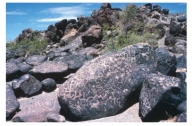
A) contact metamorphism
B) unconformity
C) desert varnish
D) desert pavement
E) none of these
Correct Answer

verified
Correct Answer
verified
Multiple Choice
This figure shows two sections that partially overlap in age.Dashed lines show how the two sections correlate.What can you conclude from these correlations? 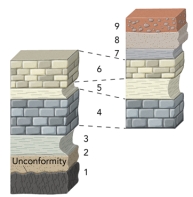
A) the oldest unit is unit 4
B) the youngest unit is unit 6
C) the rate at which unit 5 was deposited was constant across the area
D) the left section represents older rocks than the right section
E) none of these
Correct Answer

verified
Correct Answer
verified
Multiple Choice
This figure shows two sections of rocks.What is the youngest unit? 
A) unit 1
B) unit 4
C) unit 6
D) unit 9
E) none of these
Correct Answer

verified
Correct Answer
verified
Multiple Choice
Which of the following is the earliest (oldest) chapter of geologic time?
A) Cenozoic
B) Mesozoic
C) Paleozoic
D) Precambrian
Correct Answer

verified
Correct Answer
verified
Multiple Choice
Which of the following is a reason why rock units may change from one section to another?
A) facies change
B) restricted aerial distribution
C) removed along an unconformity or disconformity
D) eroded away
E) all of these
Correct Answer

verified
Correct Answer
verified
Multiple Choice
Using the data in this table,calculate the number of half-lives that have passed for the dike (unit D on this table) . 
A) 1
B) 2
C) 3
D) 4
E) 5
Correct Answer

verified
Correct Answer
verified
Multiple Choice
This figure shows two fault scarps,a lava flow,and erosion along one of the scarps.What is probably the oldest feature of those listed below? 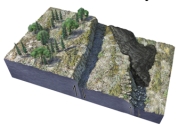
A) the scarp on the left
B) the scarp on the right
C) the lava flow
D) erosion of the scarp on the right
Correct Answer

verified
Correct Answer
verified
Multiple Choice
The geologic relationships in this figure indicate that the lava flow: 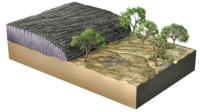
A) pushed the trees over
B) overlies an angular unconformity
C) is younger than the landscape surface partially covered by the lava flow
D) that materials beneath the lava flow were uplifted from great depth
Correct Answer

verified
Correct Answer
verified
Multiple Choice
Which of the numbered features is the oldest? 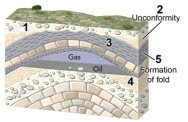
A) conglomerate (1)
B) unconformity (2)
C) shale layer (3)
D) lower sedimentary units (4)
E) formation of the fold (5)
Correct Answer

verified
Correct Answer
verified
Multiple Choice
How would we use isotopic ages to infer the ages of the upper and lower unit in this diagram? 
A) The lower unit would be younger than an age on the crosscutting dike.
B) The upper unit would be older than an age determined on pebbles of the dike in that unit.
C) The dike is younger than the lower unit but older than the upper unit.
D) An age on the dike would not help us because it is an igneous rock.
Correct Answer

verified
Correct Answer
verified
Multiple Choice
What type of feature is shown in this photograph of Siccar Point,Scotland? 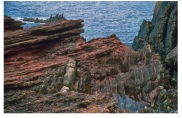
A) monocline
B) thrust fault
C) normal fault
D) unconformity
Correct Answer

verified
Correct Answer
verified
Multiple Choice
The highest surface on this figure is a river terrace.This terrace: 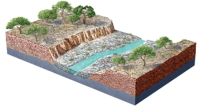
A) is older than the modern river channel
B) formed sometime in the past
C) predates erosion down to the present level
D) all of these
Correct Answer

verified
Correct Answer
verified
Showing 61 - 80 of 99
Related Exams